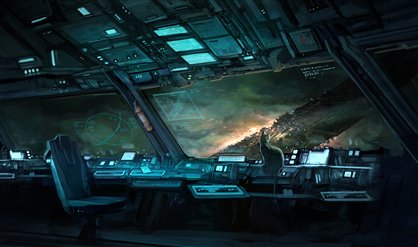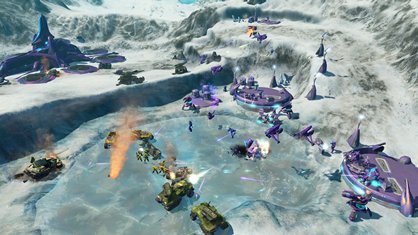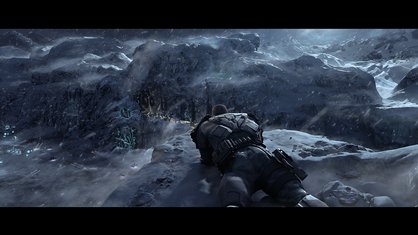Exclusive interview with the Lead Designer of Halo Wars
How they created a Flood world from 100 feet off the ground
GR: Were there any places you wanted to create that didn’t make the cut? Were they too extreme?
DP: Yeah, like most games, we always want to do more than we have time for. Halo Wars is no exception. The original story had a couple more locales to visit. I wouldn’t say they were “too extreme,” but they just weren’t a big enough “bang for the buck.” In the end, we were able to bring those plot points out in the between-mission cinematics. We were definitely able to extend the locations in the game through those cinematics. In addition to just being drop-dead gorgeous, the cinematics pack a lot of storytelling. There are roughly 26 minutes of content sprinkled throughout the campaign. We get a chance to showcase things like the Spirit of Fire bridge and a few other unique environments through those cinematics.

GR: How much were you trying to recreate the environment and feeling of the first three Halo games and how much were you trying to create something new?
DP: That’s an easy answer: 50/50. In truth, I think any game that looks to take an existing franchise like Halo in a different direction has to hit on both points to be a success. We have to make the experience unmistakably scream “HALO!!!” to all the fans. But, at the same time, we have to follow up on the expectations we set by making a strategy game and offering something new to players. If the story we tell and the environments we use have already been seen, then why did we go to the trouble of making it a strategy game? I think we had to create new characters, locations and units in order for our Halo game to stand alone as a triple-A game. Anything less would have been viewed by everyone (us included) as something like a mod or expansion.
As it turns out, doing those things really helped reinforce the changes in gameplay. Creating a new cast of characters helps differentiate the Halo Wars story from the more singular focus of the Master Chief story in the previous Halo games. I’m not sure we thought about it explicitly upfront versus realizing it part of the way through, but it is something we paid a lot of attention to throughout the second half of the game’s development.

GR: How do the environments show that we’re playing a Halo game, and that it’s in the same universe we’ve seen Master Chief running around and single-handedly blowing everything up even though our marines keep getting mowed down as fast as we can pump them out?
DP: When we started working on Halo Wars, we spent a lot of time talking with Bungie about what defines a Halo game. If you step back and take a broad look at Halo, you quickly realize it’s one of the more vibrant shooters out there. Sure, it’s got a few dark and scary levels, but a lot of the action takes place in lush tropical environments or classic snowy tundras. That’s awesome for us given our background with Age of Empires. We were able to really leverage the experience we’ve developed over the last 15 years and bring it straight into creating those lush Halo levels. Plus, it really helps the game pop off the TV screen when it’s really bright and inviting.
Sign up to the GamesRadar+ Newsletter
Weekly digests, tales from the communities you love, and more
GR: Is most of the game spent on the planet Harvest? Or will we be seeing other worlds and indoor ship battles? Which type of battle is the most awesomest?
DP: The campaign and skirmish maps have a pretty even split across all four of our main terrain sets. Harvest is the first planet in the campaign, so we get a chance to hearken back to all those great snowy Halo levels right away. From there, the story takes you to Arcadia, which is a lush, steamy jungle planet. Well, at least it used to be. We do have a really cool level involving a ship, but it’s not exactly indoors. Anything more would be too much of a spoiler. Of all the terrains we have in the game, I’d have to say that I enjoy the Flood world the best. It’s just such a great match for the Halo fiction and gameplay to have this evil landscape that wants nothing more than to devour and mutate everyone in your army.

GR: What challenges did you run into trying to take concept art and create a real game world? Did you have to let anything go that you really wanted to include in the finished product?
DP: There are tons of concepts that never made it into the final game. Some of those died on the concept table, others went in the game and then left due to design changes.
One good example is the Fox Cannon. This was conceived as an anti-vehicle infantry unit for the UNSC. It went through various incarnations. One of them was two dudes carrying around this massive gun, and another was a wheeled vehicle/infantry thing that kinda looked like a 17th century cannon. In the end, that unit eventually morphed into the vehicle unit called the Cobra. We changed the name from Fox to Cobra because Cobra sounded meaner than Fox. Anyhow, those unused concepts were all good things, but they just didn’t quite fit into the final design the exact way we needed them to.
Another good example is the second mission in the campaign. In the final version, you build up a base and go assault a mild Covenant defense force. Originally, the mission was a small squad affair that focused more on just training units. You’d walk over here, train a few units, avoid the Jackal snipers as you walked over, train a few more units, etc. The mission itself was fine, but when we sat down to play the first quarter of the campaign, we realized that we weren’t teaching things fast enough. We had to put more base building in the second mission. We tried tons of ways to make that work, but in the end, we had to scrap the entire mission and start it over.


